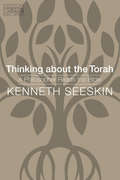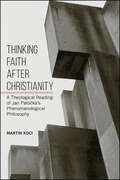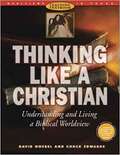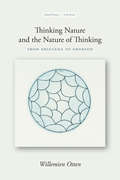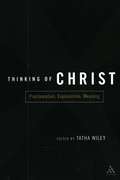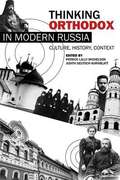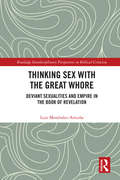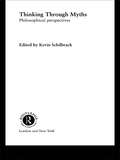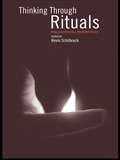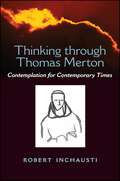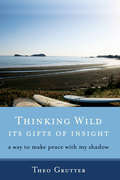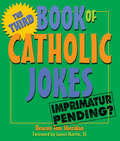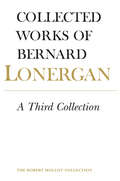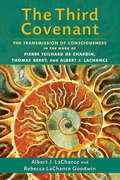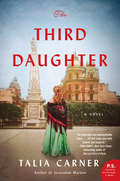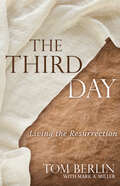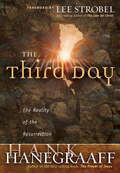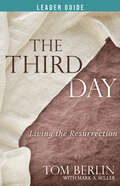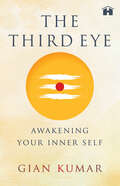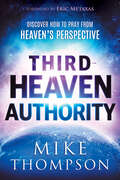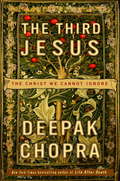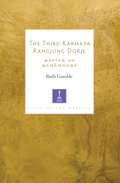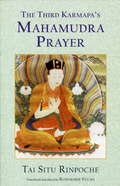- Table View
- List View
Thinking about the Torah: A Philosopher Reads the Bible (JPS Essential Judaism)
by Kenneth SeeskinThe Bible is an enduring source of inspiration for the human heart and mind, and readers of Thinking about the Torah will be rewarded with an enhanced understanding of this great work’s deeper meanings. Drawing on Western philosophy and particularly Jewish philosophy, Kenneth Seeskin delves into ten core biblical verses and the powerful ideas that emerge from them. He speaks to readers on every page and invites conversation about topics central to human existence: how finite beings can relate to the infinite, what love is, the role of ethics in religion, and the meaning of holiness. Seeskin raises questions we all ask and responds to them with curiosity and compassion, weaving into his own perceptive commentary insights from great Jewish thinkers such as Maimonides, Spinoza, Buber, Rosenzweig, and Levinas, as well as Plato, Aristotle, Augustine, Luther, Kant, and Kierkegaard. The Bible is concerned with how we think as well as how we follow the commandments, rituals, and customs. Seeskin inspires us to read the Torah with an open mind and think about the lessons it teaches us.
Thinking Faith after Christianity: A Theological Reading of Jan Patočka's Phenomenological Philosophy (SUNY series in Theology and Continental Thought)
by Martin KociWinner of the 2020 Emerging Scholar’s Theological Book Prize presented by the European Society for Catholic TheologyThis book examines the work of Czech philosopher Jan Patočka from the largely neglected perspective of religion. Patočka is known primarily for his work in phenomenology and ancient Greek philosophy, and also as a civil rights activist and critic of modernity. In this book, Martin Koci shows Patočka also maintained a persistent and increasing interest in Christianity. Thinking Faith after Christianity examines the theological motifs in Patočka's work and brings his thought into discussion with recent developments in phenomenology, making a case for Patočka as a forerunner to what has become known as the theological turn in continental philosophy. Koci systematically examines his thoughts on the relationship between theology and philosophy, and his perennial struggle with the idea of crisis. For Patočka, modernity, metaphysics, and Christianity were all in different kinds of crises, and Koci demonstrates how his work responded to those crises creatively, providing new insights on theology understood as the task of thinking and living transcendence in a problematic world. It perceives the un-thought element of Christianity—what Patočka identified as its greatest resource and potential—not as a weakness, but as a credible way to ponder Christian faith and the Christian mode of existence after the proclaimed death of God and the end of metaphysics.
Thinking Like a Christian: Understanding and Living a Biblical Worldview (Worldviews in Focus)
by Chuck Edwards David A. NoebelFrom TV news to public school classrooms, secular ideas are presented as 'the way to think'-sophisticated and scientific, contemporary and aware. Even though they're infected with an array of false assumptions. Yet Christians too easily succumb because they don't understand how remarkable it is to view the world from a biblical perspective. <p><p> Designed to build a young person's assurance that a Bible-based worldview makes sense. Includes CD-ROM Leader's Guide.
Thinking Nature and the Nature of Thinking: From Eriugena to Emerson (Cultural Memory in the Present)
by Willemien OttenA fresh and more capacious reading of the Western religious tradition on nature and creation, Thinking Nature and the Nature of Thinking puts medieval Irish theologian John Scottus Eriugena (810–877) into conversation with American philosopher Ralph Waldo Emerson (1803–1882). Challenging the biblical stewardship model of nature and histories of nature and religion that pit orthodoxy against the heresy of pantheism, Willemien Otten reveals a line of thought that has long made room for nature's agency as the coworker of God. Embracing in this more elusive idea of nature in a world beset by environmental crisis, she suggests, will allow us to see nature not as a victim but as an ally in a common quest for re-attunement to the divine. Putting its protagonists into further dialogue with such classic authors as Augustine, Maximus the Confessor, Friedrich Schleiermacher, and William James, her study deconstructs the idea of pantheism and paves the way for a new natural theology.
Thinking of Christ: Proclamation, Explanation, Meaning
by Tatha WileyThis is a textbook on Christology for the undergraduate, graduate, and seminary market written by eleven distinguished North American Roman Catholic theologians. The structure of the book and of the individual essays follows a pattern of recovery (analysis of the tradition), critique (consideration of special problems), and reconstruction (distinctive Christologies in the contemporary American context). Part 1, devoted to historical recovery, treats Jesus of Nazareth and the significance of historical Jesus research for Christology today; Christological developments resulting in the conciliar definitions of Nicaea and Chalcedon; and diverse conceptions of Christ's redemption in the early and medieval church. Part II treats four problems in modern debate: religious pluralism and Christian exclusivist claims; theological anti-Semitism embedded in Christological formulations; legitimation of male privilege via appeals to the masculinity of Jesus and Christ's headship of the church; the use of the Christ symbol,to legitimate colonialism and racial exploitation. Finally, Part III offers two examples of contemporary Christologies of social transformation: mujerista Christology and black Christology.
Thinking Orthodox in Modern Russia
by Patrick Lally Michelson Judith Deutsch Kornblatt"Thinking Orthodox in Modern Russia" illuminates the significant role of Russian Orthodox thought in shaping the discourse of educated society during the imperial and early Soviet periods. Bringing together an array of scholars, this book demonstrates that Orthodox reflections on spiritual, philosophical, and aesthetic issues of the day informed much of Russia's intellectual and cultural climate. Volume editors Patrick Lally Michelson and Judith Deutsch Kornblatt provide a historical overview of Russian Orthodox thought and a critical essay on the current state of scholarship about religious thought in modern Russia. The contributors explore a wide range of topics, including Orthodox claims to a unique religious Enlightenment, contests over authority within the Russian Church, tensions between faith and reason in academic Orthodoxy, the relationship between sacraments and the self, the religious foundations of philosophical and legal categories, and the effect of Orthodox categories in the formation of Russian literature. "
Thinking Sex with the Great Whore: Deviant Sexualities and Empire in the Book of Revelation (Routledge Interdisciplinary Perspectives on Biblical Criticism)
by Luis Menéndez-AntuñaMany scholars in Biblical and Revelation studies have written at length about the imperial and patriarchal implications of the figure of the Whore of Babylon. However, much of the focus has been on the links to the Roman Empire and ancient attitudes towards gender. This book adds another layer to the conversation around this evocative figure by pursuing an ideological critique of the Great Whore that takes into account contemporary understandings of sexuality, and in so doing advances a de-moralization of apparent sexual deviancy both in the present and in the past. Offering an emancipatory reading of Revelation 17-18 using Foucauldian, postcolonial and queer historiographies, this study sets out alternative paths for identity construction in Biblical texts. By using these alternative critical lenses, the author argues that the common neglect of the ethical and political impact of Biblical texts in the present can be overcome. This, in turn, allows for fresh reflection on the study of the Bible and its implications for progressive politics. Situated at the intersection of Revelation Studies, Biblical Studies and Hermeneutics, as well as Contextual/Liberationist Theologies and Queer and Postcolonial Criticism, this is a cutting edge study that will be of keen interest to scholars of Theology and Religious Studies.
Thinking Through Myths: Philosophical Perspectives
by Kevin SchilbrackEight outstanding essays, from leading academics, deconstruct perennial problems of rationality, imagination and narrative to trace the influence of myth in our own beliefs, origins, and potential futures. Thinking Through Myths attempts to reconcile the opposed claims of pragmatism and beauty, calling for the acknowledgement of myths in everyday experience.
Thinking through Paul: A Survey of His Life, Letters, and Theology
by Bruce W. Longenecker Todd D. StillThe study of Paul and his letters can be exciting, challenging, and life-changing, but only if it is done well and only if students achieve more than a basic familiarity with the subject. This is exactly what Pauline experts Bruce W. Longenecker and Todd D. Still accomplish with their new textbook aimed at college and seminary level courses on Paul and his writings. Longenecker and Still bring decades of study and expertise to Thinking through Paul, challenging readers to delve deeply into Paul’s writings and wrestle with his richly-layered and dynamic theological discourse. Seeking to situate their study of the Apostle in proper perspective, Longenecker and Still first look at Paul’s life before and after his encounter with the risen Christ en route to Damascus, then examine each of Paul’s letters individually, and finally synthesize the Pauline writings to highlight the main strands of Paul’s theologizing—all the while keeping in mind the particular context of first-century Christianity. Filled with images, maps, charts, and questions for further study and discussion, Thinking through Paul is both engaging and easy-to-follow, making it the perfect choice for classrooms and for interested readers.
Thinking Through Rituals: Philosophical Perspectives
by Kevin SchilbrackMany philosophical approaches today seek to overcome the division between mind and body. If such projects succeed, then thinking is not restricted to the disembodied mind, but is in some sense done through the body. From a post-Cartesian perspective, then, ritual activities that discipline the body are not just thoughtless motions, but crucial parts of the way people think.Thinking Through Rituals explores religious ritual acts and their connection to meaning and truth, belief, memory, inquiry, worldview and ethics. Drawing on philosophers such as Foucault, Merleau-Ponty and Wittgenstein, and sources from cognitive science, pragmatism and feminist theory, it provides philosophical resources for understanding religious ritual practices like the Christian Eucharistic ceremony, Hatha Yoga, sacred meditation or liturgical speech. Its essays consider a wide variety of rituals in Christianity, Judaism, Hinduism and Buddhism - including political protest rituals and gay commitment ceremonies, traditional Vedic and Yogic rites, Christian and Buddhist meditation and the Jewish Shabbat. They challenge the traditional disjunction between thought and action, showing how philosophy can help to illuminate the relationship between doing and meaning which ritual practices imply.
Thinking through Thomas Merton: Contemplation for Contemporary Times
by Robert InchaustiWith the publication of The Seven Storey Mountain in 1948, Thomas Merton became a bestselling author, writing about spiritual contemplation in a modern context. Although Merton (1915–1968) lived as a Trappist monk, he advocated a spiritual life that was not a retreat from the world, but an alternative to it, particularly to the deadening materialism and spiritual vacuity of the postwar West. Over the next twenty years, Merton wrote for a wide audience, bringing the wisdom of Christianity, Buddhism, and Sufism into dialogue with the period's contemporary thought.In Thinking through Thomas Merton, Robert Inchausti introduces readers to Merton and evaluates his continuing relevance for our time. Inchausti shows how Merton broke the high modernist trance so that we might become the change we wish to see in the world by refiguring the lost virtues of silence, contemplation, and community in a world enamored by the will to power, virtuoso performance, radical skepticism, and materialist metaphysics. Merton's defense of contemplative culture is considered in light of the postmodern thought of recent years and emerges as a compelling alternative.
Thinking Wild: Its Gifts of Insight - A Way to Make Peace with My Shadow
by Theo GrutterTheo Grutter is a big, friendly bear of an unpretentious, spontaneous outdoorsman. Born and educated mostly in Switzerland to enter the corporate world, he soon discovered that this life wasn't for him. He moved to Paris and married Clara, a concert pianist. They landed in New York to search for a lifestyle more to their liking in which to raise a family, which soon grew to include five children. They lived in many places, finally settling in a small Mexican Pacific coast fishing village in winter and traveling up to Sitka, Alaska in the summers, where Theo still fishes as a solitary commercial fisherman. Theo and Clara took yearly walkabouts in many exotic countries of the world, with Theo ever observing, learning, and writing about how life works on Earth. Thinking Wild is the fruit of twelve years' work, a series of essays carved in Theo's non-native and poetic English, written by a remarkable man with deep insight, a fisher philosopher, a seer and seeker railing against man's disrespect of other lifeforms on Earth. All is shared by a man who sees his life as his work of art, and treads a path towards a new way of seeing life more lovingly.
Third Book of Catholic Jokes
by Deacon SherdianAs Pope Benedict XVI has said, "A writer once said that angels can fly because they don't take themselves too seriously. Maybe we could also fly a bit if we didn't think we were so important." Imagine the pontiff, now in his eighties and undoubtedly feeling the pains of growing older himself, cracking a joke about it to one of the cardinals in the Vatican. So must every married couple do as they go about the business of maintaining a loving, committed relationship...but discover that they still get on each other's nerves occasionally.Here is The Third Book of Catholic Jokes, chosen and told by Deacon Tom Sheridan, the former editor of The Catholic New World, the newspaper of the Archdiocese of Chicago. He is now retired and living with his wife in Florida. The book also features a Foreword by Father James Martin, SJ, the culture editor of America magazine and the author of Between Heaven and Mirth: Why Joy, Humor and Laughter Are at the Heart of the Spiritual Life.This edition of this popular series of books focuses on the universal--and often hilarious--human experience of relating to one another and growing old together. These stories, jokes, lists, and one-liners are mostly about lay people and are told from a "Catholic" (that is, Roman Catholic) or a "catholic" (that is, universal and about everyone) perspective. They are "clean" and not "mean" and are certainly not intended to offend anyone of any faith or situation in life. But if we can't make fun of ourselves about the difficulties of growing older or trying to maintain our most intimate relationships over a lifetime, then how can we ever expect to "fly a bit"?
A Third Collection: Volume 16
by Bernard Lonergan John Dadosky Lonergan Research Institute Robert Doran, S.J.A Third Collection, prepared for the Collected Works of Bernard Lonergan by editors Robert M. Doran and John D. Dadosky, is a helpful companion to volumes four and thirteen in the series. The volume contains fifteen papers, written between 1974 and 1982, and includes some of his most important shorter writings such as "Prolegomena to the Study of the Emerging Religious Consciousness of Our Time" and "Natural Right and Historical Mindedness." The relevant archival entries are specified, so that readers can consult them. The papers in this volume rehearse in a new key the themes of a lifetime. Without in any way going back on the major emphases of Lonergan's early work–cognitional theory and then the exploration of a fourth, existential level of consciousness– they are focused more on love and on the movement from above downwards in consciousness. Community is emphasized as the context and the fruit of the emergence of authentic subjects.
The Third Covenant
by Albert J. Lachance Rebecca Lachance GoodwinThe Third Covenant explores the work of Pierre Teilhard de Chardin, Thomas Berry, and Albert LaChance, revealing through the lens of spirituality, science, and ecology, their understanding of human origin and evolution. Pierre Teilhard de Chardin, an early twentieth century geologist and priest, devoted his life as a scientist, clergyman, and mystic, to reuniting the artificial fracture between science and religion. Thomas Berry, a follower of Teilhard de Chardin and a highly respected cultural historian, furthered this reunification by repositioning the human in the unfolding of an evolving universe, integrated and interdependent with the rest of the life systems of the planet. Albert LaChance, himself a six-year, face-to-face student of Berry, brought this new paradigm into his work as a poet, psychologist, addiction recovery professional, and most importantly, as a mystic and scholar of religion. Along with his daughter, Rebecca LaChance Goodwin, LaChance explores the development of this crucial shift in human understanding and its implications for the future.Parts I and II explore the elements of polarized thinking that makes us believe that we are separate from each other and the life systems of the planet. Thomas Berry's list of twelve principles for understanding the universe and the role of the human in the universe process describes the creative unfolding of our place in the universe. Part III introduces practical steps for achieving personal, familial, and cultural change. LaChance outlines his Twelve Steps of Ecological Spirituality to help us move from powerlessness and isolation to a state of reawakening to self, to humanity, to all species, to the planet, and to the universe.
The Third Daughter: A Novel
by Talia Carner“In The Third Daughter, Talia Carner ably illuminates a little-known piece of history: the sex trafficking of young women from Russia to South America in the late 19th century. Thoroughly researched and vividly rendered, this is an important and unforgettable story of exploitation and empowerment that will leave you both shaken and inspired.” —Pam Jenoff, New York Times bestselling author of The Lost Girls of ParisThe turn of the 20th century finds fourteen-year-old Batya in the Russian countryside, fleeing with her family endless pogroms. Desperate, her father leaps at the opportunity to marry Batya to a worldly, wealthy stranger who can guarantee his daughter an easy life and passage to America. Feeling like a princess in a fairytale, Batya leaves her old life behind as she is whisked away to a new world. But soon she discovers that she’s entered a waking nightmare. Her new “husband” does indeed bring her to America: Buenos Aires, a vibrant, growing city in which prostitution is not only legal but deeply embedded in the culture. And now Batya is one of thousands of women tricked and sold into a brothel.As the years pass, Batya forms deep bonds with her “sisters” in the house as well as some men who are both kind and cruel. Through it all, she holds onto one dream: to bring her family to America, where they will be safe from the anti-Semitism that plagues Russia. Just as Batya is becoming a known tango dancer, she gets an unexpected but dangerous opportunity—to help bring down the criminal network that has enslaved so many young women and has been instrumental in developing Buenos Aires into a major metropolis.A powerful story of finding courage in the face of danger, and hope in the face of despair, The Third Daughter brings to life a dark period of Jewish history and gives a voice to victims whose truth deserves to finally be told.
The Third Day: Living the Resurrection
by Tom Berlin Mark A. MillerOn the third day, he rose again.In The Third Day: Living the Resurrection, Tom Berlin uses his gifts of storytelling and understanding the Scriptures to connect the reader to the experiences of several individuals around Jesus in his final days, focusing on new life and redemption rather than loss.Join Peter, Mary Magdalene, and Thomas as they feel the despair of losing Jesus and the surprise and joy that awaits them in the resurrection. This study traces events around these characters, along with Paul and the disciples at Emmaus, and how the resurrection transforms their lives.The book can be read alone or used for a six-week group study and church-wide Lenten program. Components include a comprehensive Leader Guide and video teaching sessions featuring Tom (with closed captioning).
The Third Day: The Reality of the Resurrection
by Hank HanegraaffThe foundation of Christian faith, the resurrection of Jesus Christ, is defended in detail in this powerful work from author Hank Hanegraaff's bestseller Resurrection. Factual evidences are examined, from the fatal torment and empty tomb to Christ's appearances and transformation. Believers will find this chronicle of immense help in defending their faith with tangible proof and in terms the secular world can appreciate and understand. Not merely a shield for spiritual battle, this book is a torch to arm Christians with a convincing case study of the resurrection of Jesus Christ.As Joni Eareckson Tada said, "Hands down, slam-dunk, the resurrection is the bottom line for the believer. Hank leaves no stone unturned, thoroughly portraying the resurrection as our grand hope, the glorious springboard from which we will dive into eternity."
The Third Day Leader Guide: Living the Resurrection
by Tom Berlin Mark A. MillerOn the third day, he rose again.The Leader Guide contains everything needed to guide a group through the six-week study, including session plans, activities, discussion questions, and multiple format options. In The Third Day: Living the Resurrection, Tom Berlin uses his gifts of storytelling and understanding the Scriptures to connect the reader to the experiences of several individuals around Jesus in his final days, focusing on new life and redemption rather than loss.Join Peter, Mary Magdalene, and Thomas as they feel the despair of losing Jesus and the surprise and joy that awaits them in the resurrection. This study traces events around these characters, along with Paul and the disciples at Emmaus, and how the resurrection transforms their lives.Additional components include the book, The Third Day: Living the Resurrection, and video teaching sessions featuring Tom(with closed captioning).
The Third Eye: Awakening Your True Self
by Gian KumarThe Third Eye takes you beyond spirituality, distancing the self from its doing, towards a higher knowledge where you are neither the observer, knower, doer, enjoyer nor the experiencer. You are neither the physical nor that mental being, for they are but temporarily yours . . . appearing and disappearing in that ocean of awareness. You are that formless, eternal presence of universal aware energy performing the Lila of life as the witness, which radiates through its field of consciousness. In fact, you are merely an I-less state of that being-ness, the subject of observation, observing through your mind on the objects being observed. The subject of spiritualism is indifferent to the world of emotions. It goes beyond passion and compassion into dispassion; it is sensitive to all as one. Through this sublime subject, the author takes you away from those scriptures prescribed by Krishna, Jesus, or Buddha into a state of non-being, beyond space and time, entrapped in an individualized soul—the role it plays during the making of what you are. You, as the spirit, do not transmute but only watch in silence—beyond all efforts and methods—effortlessly witnessing all that is around. This book will enthral and enchant every serious spiritual seeker, those who wish to know the beyond of all beyond.
Third-Heaven Authority: Discover How to Pray From Heaven's Perspective
by Mike ThompsonWhat if your whole perception of spiritual authority is wrong? This book will guide you to walk in the supernatural authority Christ has given you. You will learn how to view life from a heavenly perspective instead of an earthly one so that you avoid all the deceptive traps of the enemy. After thirty years of ministry, Mike Thompson had an experience that changed his life forever. In 2010, the Holy Spirit caught him up to heaven. He found himself standing before Jesus and His angels. Jesus revealed to him the great love, acceptance, and value He has for those who are new creations in Him. Then he gave Mike an in-depth teaching of spiritual authority from heaven&’s perspective, looking down. In Third-Heaven Authority, Mike shows: The activities of angels and their involvement in our daily affairsHow angels help us in spiritual warfare against demonic spirits and influencesJesus gave Mike Thompson a tall assignment: &“Teach people third-heaven authority.&” Jesus continues to take him to heaven and talk to him about authority and spiritual warfare. Inthis book, Mike shares his incredible story so that others can be encouraged and equipped for the good fight of faith. Discover sound biblical teachings combined with prophetic insight. Take your position in Christ Jesus and experience powerful answers to prayer in your own life.Readers will learn to do the following:Be more intimate with the Lord and live with more personal confidence and assertivenessDevelop a more effective prayer lifeRelease God&’s miraculous power into the circumstances surrounding them
The Third Jesus
by Deepak ChopraWho is Jesus Christ? In The Third Jesus, bestselling author and spiritual leader Deepak Chopra provides an answer to this question that is both a challenge to current systems of belief and a fresh perspective on what Jesus can teach us all, regardless of our religious background. There is not one Jesus, Chopra writes, but three.First, there is the historical Jesus, the man who lived more than two thousand years ago and whose teachings are the foundation of Christian theology and thought. Next there is Jesus the Son of God, who has come to embody an institutional religion with specific dogma, a priesthood, and devout believers. And finally, there is the third Jesus, the cosmic Christ, the spiritual guide whose teaching embraces all humanity, not just the church built in his name. He speaks to the individual who wants to find God as a personal experience, to attain what some might call grace, or God-consciousness, or enlightenment. When we take Jesus literally, we are faced with the impossible. How can we truly "love thy neighbor as thyself"? But when we see the exhortations of Jesus as invitations to join him on a higher spiritual plane, his words suddenly make sense.Ultimately, Chopra argues, Christianity needs to overcome its tendency to be exclusionary and refocus on being a religion of personal insight and spiritual growth. In this way Jesus can be seen for the universal teacher he truly is-someone whose teachings of compassion, tolerance, and understanding can embrace and be embraced by all of us.From the Hardcover edition.
The Third Karmapa Rangjung Dorje: Master of Mahamudra (Lives of the Masters)
by Ruth GambleThe first comprehensive overview of the life and writings of the Third Karmapa Rangjung Dorje, a revolutionary figure in the Kagyu tradition of Tibetan Buddhism.Known for his mastery of teachings across sectarian lines, his treatises on medicine and astrology, and his work as spiritual advisor to the last Yuan emperor of China, Rangung Dorje (1284-1339) is considered one of the most important and influential figures in Tibetan Buddhist history. First recognized as a tulku, or reincarnated Buddhist master, at the age of five, Rangjung Dorje became the Karma Kagyu lineage holder and instituted the reincarnation-based inheritance structure within Tibetan Buddhism that led to the formation of important lineages of tulkus such as the Dalai Lamas.In this groundbreaking work, Ruth Gamble synthesizes her extensive research on Rangjung Dorje into a sweeping biography covering his life, legacy, and important selected writings. Included in her discussions are Rangjung Dorje's synthesis of Dzogchen and Mahamudra in his writings, his devotion to spreading the teachings of Buddha nature, and several works never before translated into English. As the most comprehensive work available on Rangjung Dorje, this book is an indispensable resource for scholars and Buddhist practitioners alike.
The Third Karmapa's Mahamudra Prayer
by Rosemarie Fuchs Tai SituThe Mahamudra Prayer by the Third Karmapa Rangjung Dorje is a short yet thorough and profound text which presents all the essential points of Mahamudra teaching in terms of view, practice, and fruition. It is a classic that, especially in the tradition of the Karma Kagyu school of Tibetan Buddhism, has been and is widely used whenever a disciple is given a first introduction into Mahamudra. The Third Karmapa shows how to recognize our ultimate potential as a buddha. The short root text is further explained by Khentin Tai Situpa Pema Donyo Nyingje Wangpo, the twelfth incarnation of the Tai Situpa lineage, which is one of the most important lineages of the Kagyu tradition. His deep understanding of Western culture, especially of the Western psychological perspective, allows him to expound the Dharma with a clarity and directness that is truly inspiring.
The Third Karmapa's Mahamudra Prayer
by Rosemarie Fuchs Tai SituThe Mahamudra Prayer by the Third Karmapa Rangjung Dorje is a short yet thorough and profound text which presents all the essential points of Mahamudra teaching in terms of view, practice, and fruition. It is a classic that, especially in the tradition of the Karma Kagyu school of Tibetan Buddhism, has been and is widely used whenever a disciple is given a first introduction into Mahamudra. The Third Karmapa shows how to recognize our ultimate potential as a buddha. The short root text is further explained by Khentin Tai Situpa Pema Donyo Nyingje Wangpo, the twelfth incarnation of the Tai Situpa lineage, which is one of the most important lineages of the Kagyu tradition. His deep understanding of Western culture, especially of the Western psychological perspective, allows him to expound the Dharma with a clarity and directness that is truly inspiring.
